Deformation Characteristics and Response Factors of Rock Bolt Body in Roadway with Layered Composite Roof
Abstract
1. Introduction
2. Field Sampling Analysis of Roadway Rock Bolts
2.1. Engineering Background
2.2. Analysis of Deformation Characteristics of Roof Rock Bolts in 41072 Roadway of Changping Mine
3. Model Construction of Roadway with Layered Composite Roof
3.1. Numerical Simulation of Structural Plane
3.2. Numerical Model of Roadway with Layered Composite Roof
4. Simulation Realization of Rock Bolt Pile Unit
4.1. Numerical Model of Roadway with Layered Composite Roof
4.2. Method of Applying Pretension Force of Pile Unit
5. Simulation Analysis of Deformation and Stress Characteristics of Rock Bolts
5.1. Calculation Sequence
5.2. Simulation Analysis of Rock Bolt Deformation
5.3. Simulation Analysis of Rock Bolt Force
6. Analysis of Influencing Factors of Rock Bolt Body Deformation
6.1. Simulation Schemes of Different Surrounding Rock and Structural Plane Strengths
6.2. Analysis of Simulation Results
6.2.1. The Deformation Characteristics of Rock Bolts
6.2.2. The Force Analysis of Rock Bolts
7. Conclusions
Author Contributions
Funding
Data Availability Statement
Conflicts of Interest
References
- Jodeiri Shokri, B.; Mirzaghorbanali, A.; Nourizadeh, H.; McDougall, K.; Karunasena, W.; Aziz, N.; Entezam, S.; Entezam, A. Axial Load Transfer Mechanism in Fully Grouted Rock Bolting System: A Systematic Review. Appl. Sci. 2024, 14, 2076–3417. [Google Scholar] [CrossRef]
- Chen, J.; Liu, P.; Zhao, H.; Zhang, C.; Zhang, J. Analytical studying the axial performance of fully encapsulated rock bolts. Eng. Fail. Anal. 2021, 128, 105580. [Google Scholar] [CrossRef]
- Zhang, K.; Zhang, G.; Hou, R.; Wu, Y.; Zhou, H. Stress evolution in roadway rock bolts during mining in a fully mechanized longwall face, and an evaluation of rock bolt support design. Rock Mech. Rock Eng. 2015, 48, 333–344. [Google Scholar] [CrossRef]
- Zhang, C.; Bai, Q.; Han, P. A review of water rock interaction in underground coal mining: Problems and analysis. Bull. Eng. Geol. Environ. 2023, 82, 157. [Google Scholar] [CrossRef]
- Zhang, C.; Zhao, Y.; Han, P.; Bai, Q. Coal pillar failure analysis and instability evaluation methods: A short review and prospect. Eng. Fail. Anal. 2022, 138, 106344. [Google Scholar] [CrossRef]
- Chen, Y.; Xiao, H. State-of-the-art on the anchorage performance of rock bolts subjected to shear load. Int. J. Coal Sci. Technol. 2024, 11, 9. [Google Scholar] [CrossRef]
- Gu, S.C.; Wang, P.; Yang, C.F. Mechanical characteristics and stability analysis of surrounding rock reinforcement in rectangular roadway. Sci. Rep. 2022, 12, 22234. [Google Scholar] [CrossRef]
- Nourizadeh, H.; Mirzaghorbanali, A.; Serati, M.; Mutaz, E.; McDougall, K.; Aziz, N. Failure characterization of fully grouted rock bolts under triaxial testing. J. Rock Mech. Geotech. Eng. 2024, 16, 778–789. [Google Scholar] [CrossRef]
- Entezam, S.; Shokri, B.J.; Nourizadeh, H.; Motallebiyan, A.; Mirzaghorbanali, A.; McDougall, K.; Aziz, N.; Karunasena, K. Investigation of the Effect of Using Fly Ash in the Grout Mixture on Performing the Fully Grouted Rock Bolt Systems; University of Wollongong: Wollongong, NSW, Australia, 2023. [Google Scholar]
- Yu, S.; Niu, L.; Chen, J. Experimental and Numerical Studies on Bond Quality of Fully Grouted Rockbolt under Confining Pressure and Pull-Out Load. Shock Vib. 2022, 2022, 7012510. [Google Scholar] [CrossRef]
- Jodeiri Shokri, B.J.; Entezam, S.; Nourizadeh, H.; Motallebiyan, A.; Mirzaghorbanali, A.; McDougall, K.; Aziz, N.; Karunasena, K. The effect of changing confinement diameter on axial load transfer mechanisms of fully grouted rock bolts. In Proceedings of the 2023 Resource Operators Conference, University of Wollongong, Wollongong, NSW, Australia, 9–10 February 2023; pp. 290–295. [Google Scholar]
- Nourizadeh, H.; Mirzaghorbanali, A.; McDougall, K.; Jeewantha, L.; Craig, P.; Motallebiyan, A.; Shokri, B.J.; Rastegarmanesh, A.; Aziz, N. Characterization of mechanical and bonding properties of anchoring resins under elevated temperature. Int. J. Rock Mech. Min. Sci. 2023, 170, 105506. [Google Scholar] [CrossRef]
- He, M.; Ren, S.; Guo, L.; Lin, W.; Zhang, T.; Tao, Z. Experimental study on influence of host rock strength on shear performance of Micro-NPR steel bolted rock joints. Int. J. Rock Mech. Min. Sci. 2022, 159, 105236. [Google Scholar] [CrossRef]
- He, M.; Ren, S.; Xu, H.; Luo, S.; Tao, Z.; Zhu, C. Experimental study on the shear performance of quasi-NPR steel bolted rock joints. J. Rock Mech. Geotech. Eng. 2023, 15, 350–362. [Google Scholar] [CrossRef]
- Tahmasebinia, F.; Yang, A.; Feghali, P.; Skrzypkowski, K. Structural evaluation of cable bolts under static loading. Appl. Sci. 2023, 13, 1326. [Google Scholar] [CrossRef]
- Tahmasebinia, F.; Yang, A.; Feghali, P.; Skrzypkowski, K. A numerical investigation to calculate ultimate limit state capacity of cable bolts subjected to impact loading. Appl. Sci. 2022, 13, 15. [Google Scholar] [CrossRef]
- Chen, Y.; Lin, H.; Xie, S.; Ding, X.; He, D.; Yong, W.; Gao, F. Effect of joint microcharacteristics on macroshear behavior of single-bolted rock joints by the numerical modelling with PFC. Environ. Earth Sci. 2022, 81, 276. [Google Scholar] [CrossRef]
- Jiang, Y.; Zhang, S.; Luan, H.; Wang, C.; Wang, G.; Han, W. Numerical modelling of the performance of bolted rough joint subjected to shear load. Geomech. Geophys. Geo-Energy Geo-Resour. 2022, 8, 140. [Google Scholar] [CrossRef]
- Zhan, K.; Wen, X.; Wang, X.; Kong, C. A method for characterization of stress concentration degree of coal mine roadway surrounding rock. J. Geophys. Eng. 2023, 20, 699–711. [Google Scholar] [CrossRef]
- Kong, Q.; Li, Y.; Wang, S.; Yuan, C.; Sang, X. The influence of high-strength bolt preload loss on structural mechanical properties. Eng. Struct. 2022, 271, 114955. [Google Scholar] [CrossRef]
- Yi, W.; Wang, M.; Zhao, S.; Tong, J.; Liu, C. The effect of rock hardness and integrity on the failure mechanism of mortar bolt composite structure in a jointed rock mass. Eng. Fail. Anal. 2023, 143, 106831. [Google Scholar] [CrossRef]
- Peng, S. Roof bolting and underground roof falls. Geohazard Mech. 2023, 1, 32–37. [Google Scholar] [CrossRef]
- Ren, S.; Tao, Z.; He, M.; Li, M.; Sui, Q. Numerical simulation study on shear resistance of anchorage joints considering tensile–shear fracture criterion of 2G-NPR bolt. Int. J. Coal Sci. Technol. 2023, 10, 58. [Google Scholar] [CrossRef]
- Zhang, Y.; Jiang, Y.; Wang, Z.; Yin, Q.; Chen, M. Anchorage effect of bolt on en-echelon fractures: A comparison between energy-absorbing bolt and conventional rigid bolt. Eng. Fail. Anal. 2022, 137, 106256. [Google Scholar] [CrossRef]
- Yang, W.; Xia, X. Study on mining failure law of the weak and weathered composite roof in a thin bedrock working face. J. Geophys. Eng. 2018, 15, 2370–2377. [Google Scholar] [CrossRef]
- Ma, S.; Wang, Y.; Wang, H.; Gao, L. Stability mechanism and control technology of large inclined working face roof in large-scale caving area. J. Geophys. Eng. 2023, 20, 91–102. [Google Scholar] [CrossRef]
- Zhu, D.; Yu, B.; Wang, D.; Zhang, Y. Fusion of finite element and machine learning methods to predict rock shear strength parameters. J. Geophys. Eng. 2024, 21, gxae064. [Google Scholar] [CrossRef]
- Lin, J.; Shi, Y.; Sun, Z.Y.; Wang, Z.S.; Cai, J.F. Large scale model test on the distribution characteristics of the prestressed field of end-anchored bolts. Chin. J. Rock Mech. Eng. 2016, 35, 2237–2247. [Google Scholar]
- Zhang, Z.; Kang, H.P.; Wang, J.H. Pre-tensioned stress coordination function analysis of bolt-cable anchor support in coal roadway. J. China Coal Soc. 2010, 35, 881–886. [Google Scholar]
- Kang, H.P.; Jiang, P.F.; Gao, F.Q. Analysis on stability of rock surrounding heading faces and technical approaches for rapid heading. J. China Coal Soc. 2021, 46, 2023–2045. [Google Scholar]
- Cai, Y.; Esaki, T.; Jiang, Y. A rock bolt and rock mass interaction model. Int. J. Rock Mech. Min. Sci. 2004, 41, 1055–1067. [Google Scholar] [CrossRef]
- Li, C.; Stillborg, B. Analytical models for rock bolts. Int. J. Rock Mech. Min. Sci. 1999, 36, 1013–1029. [Google Scholar] [CrossRef]
- Hyett, A.J.; Moosavi, M.; Bawden, W.F. Load distribution along fully grouted bolts, with emphasis on cable bolt reinforcement. Int. J. Numer. Anal. Methods Geomech. 1996, 20, 517–544. [Google Scholar] [CrossRef]
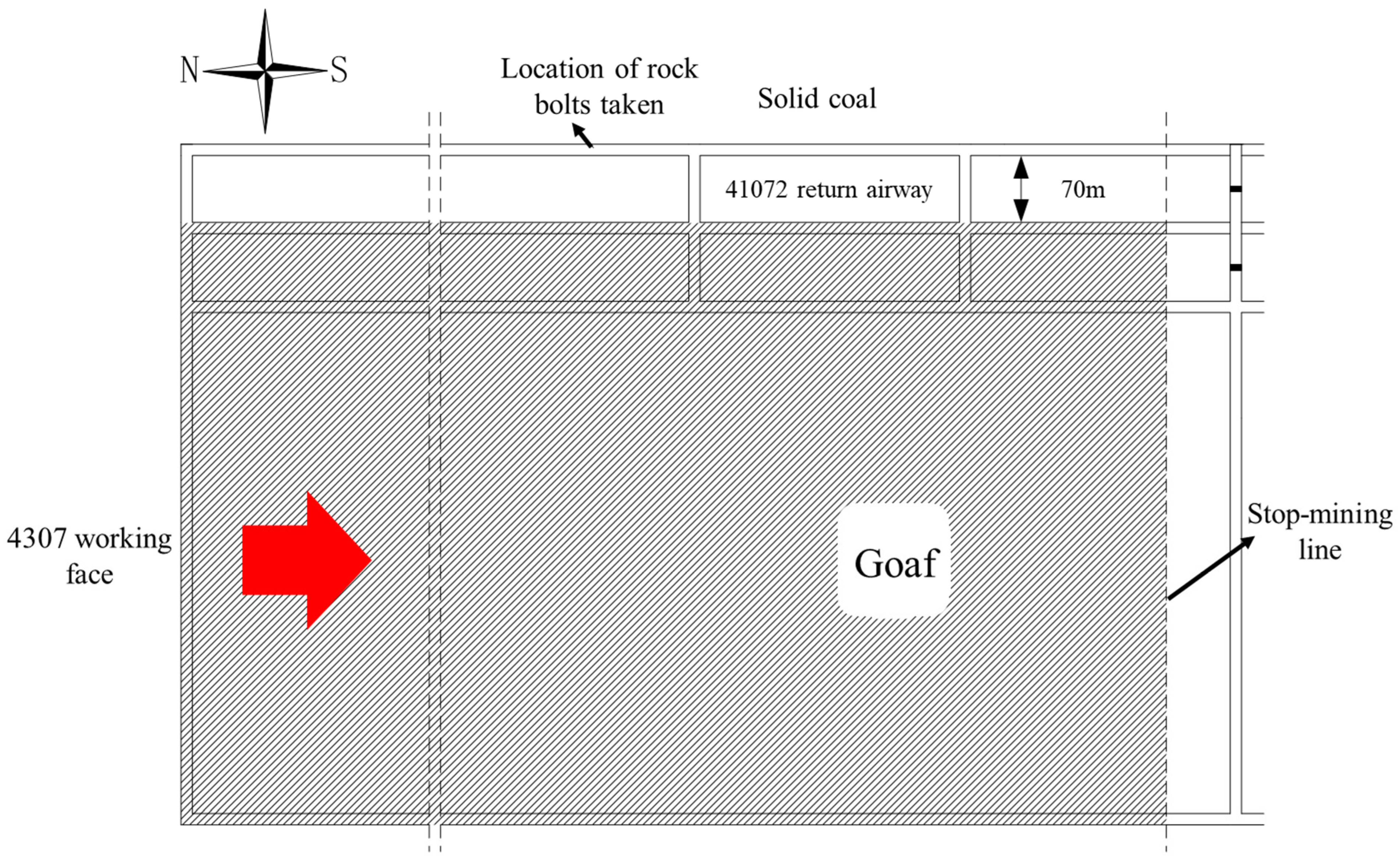

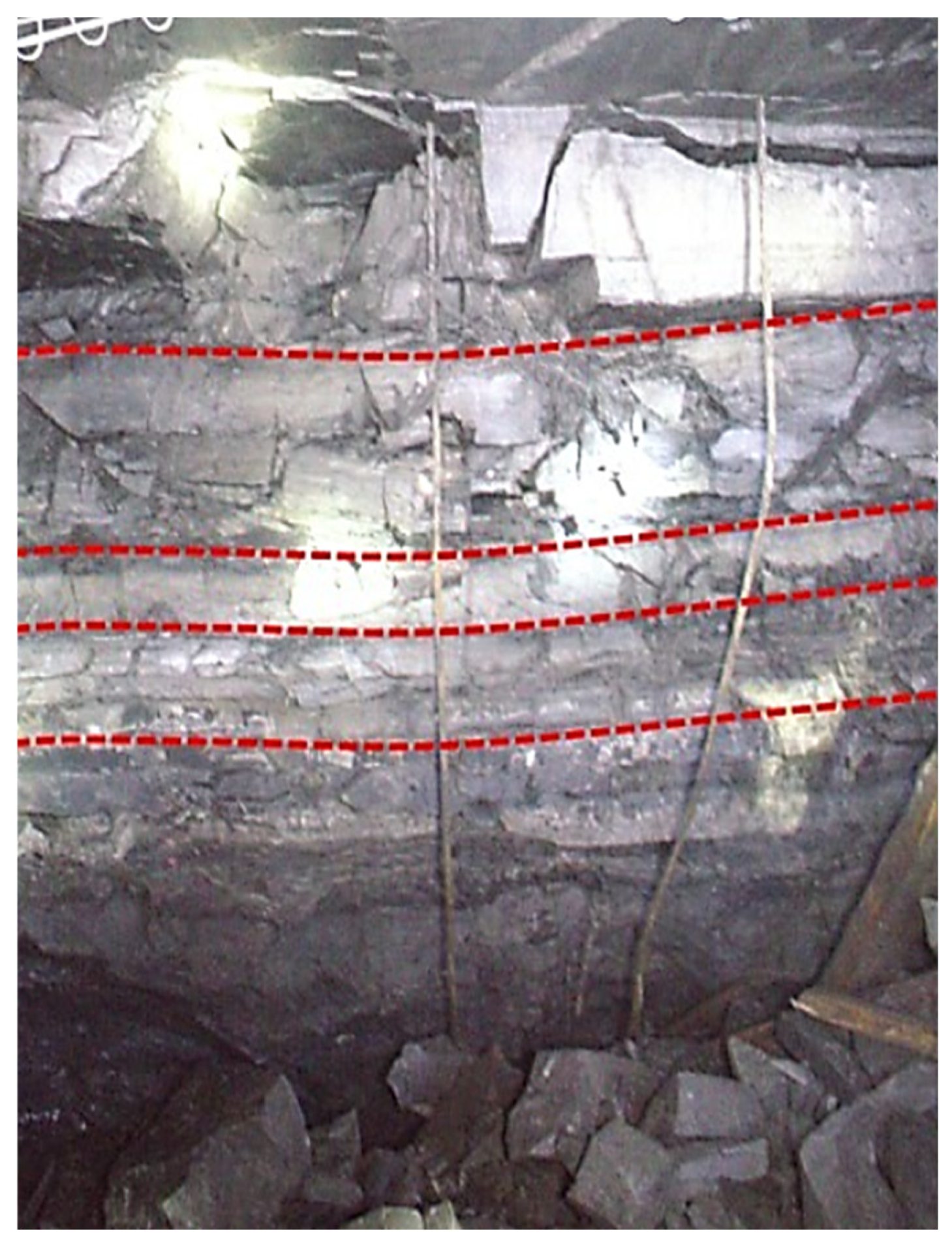
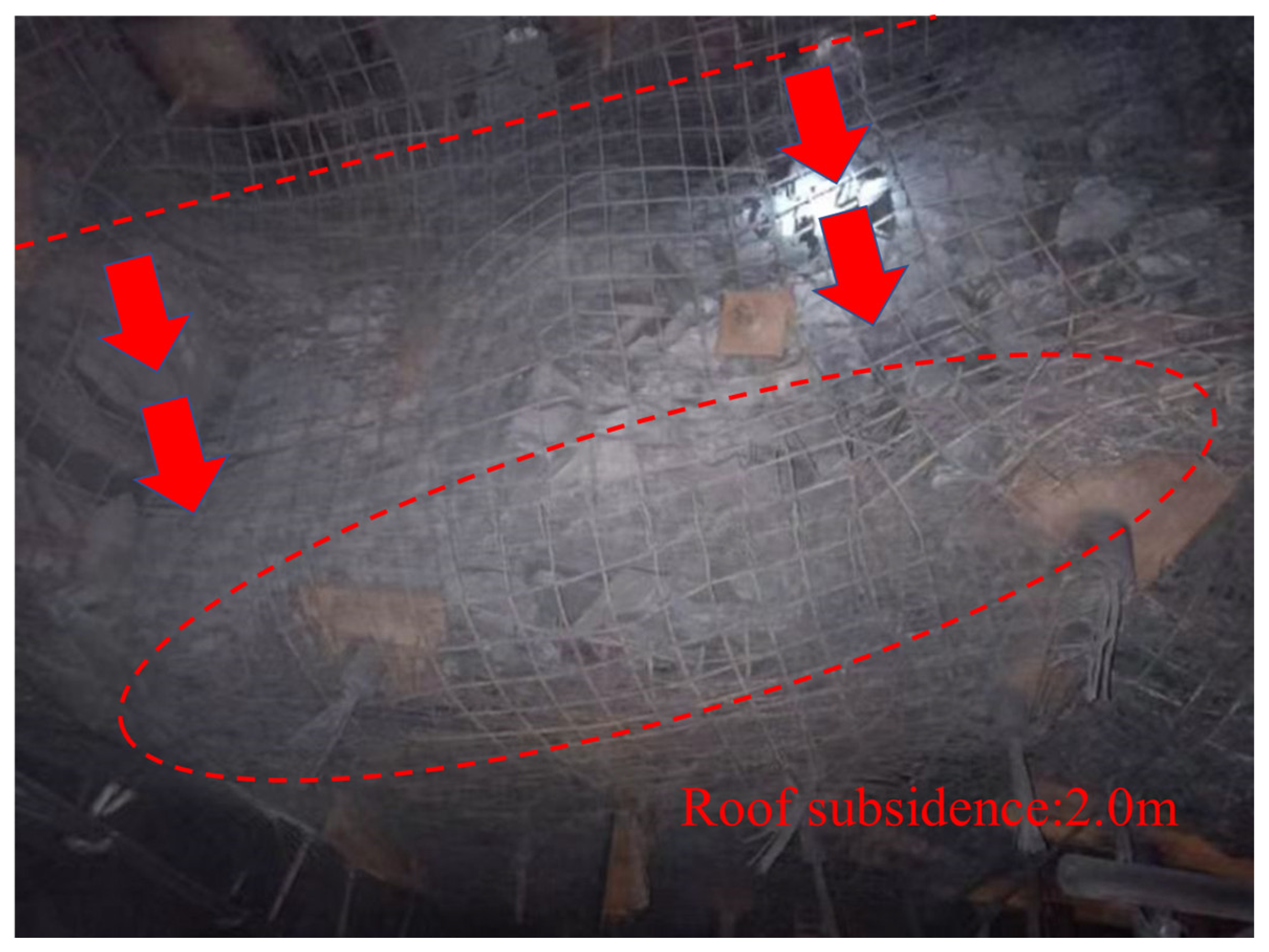
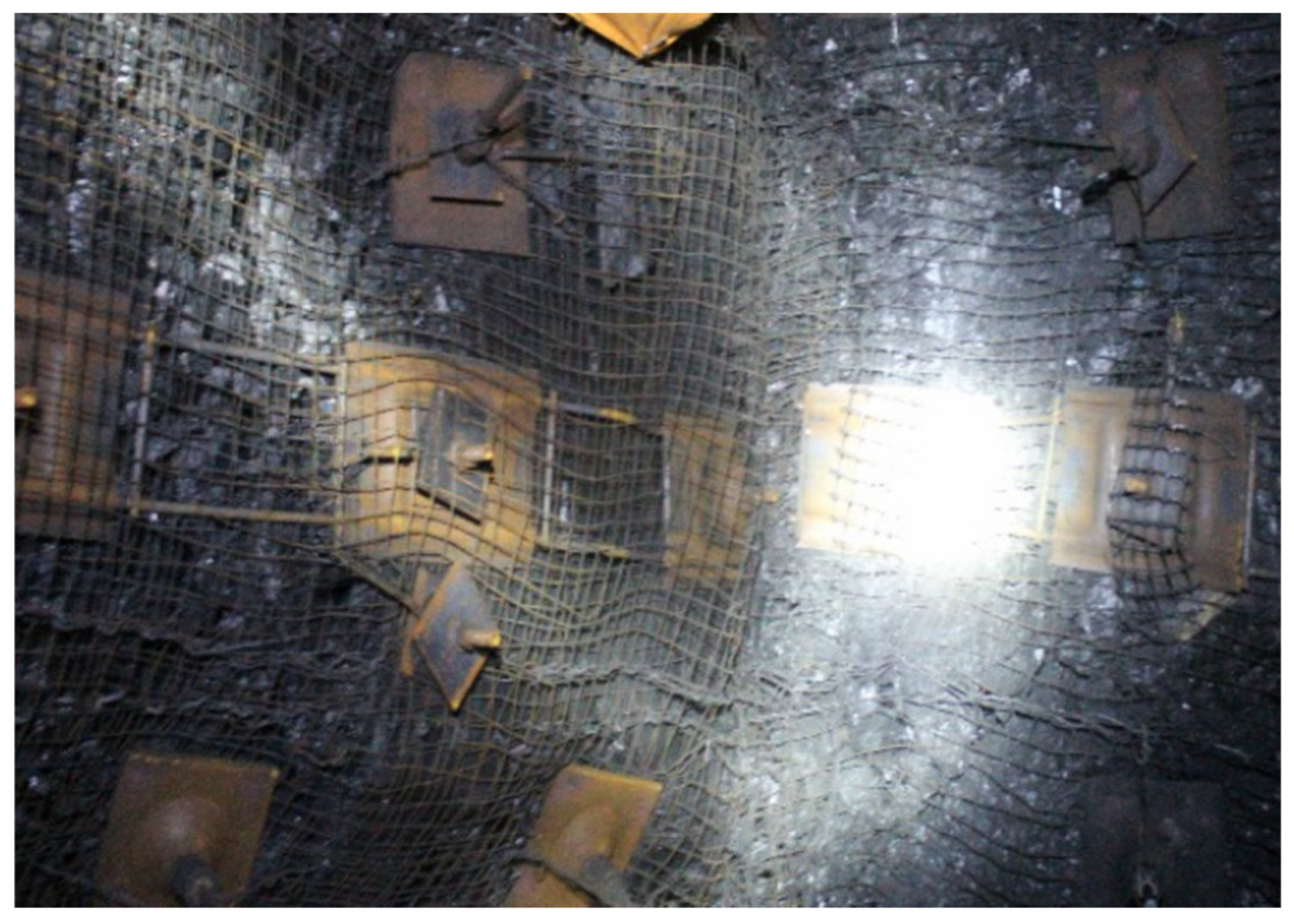





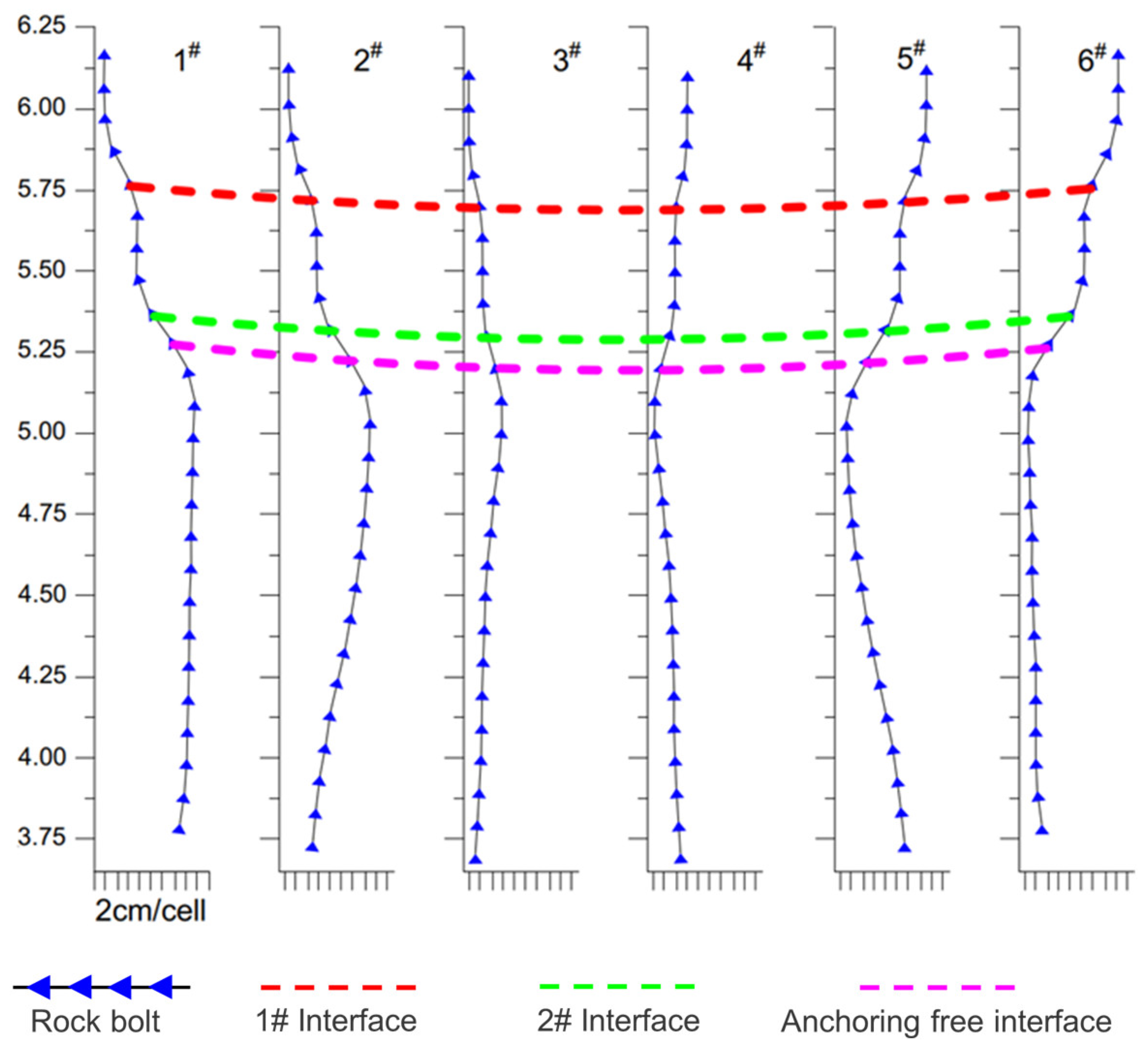
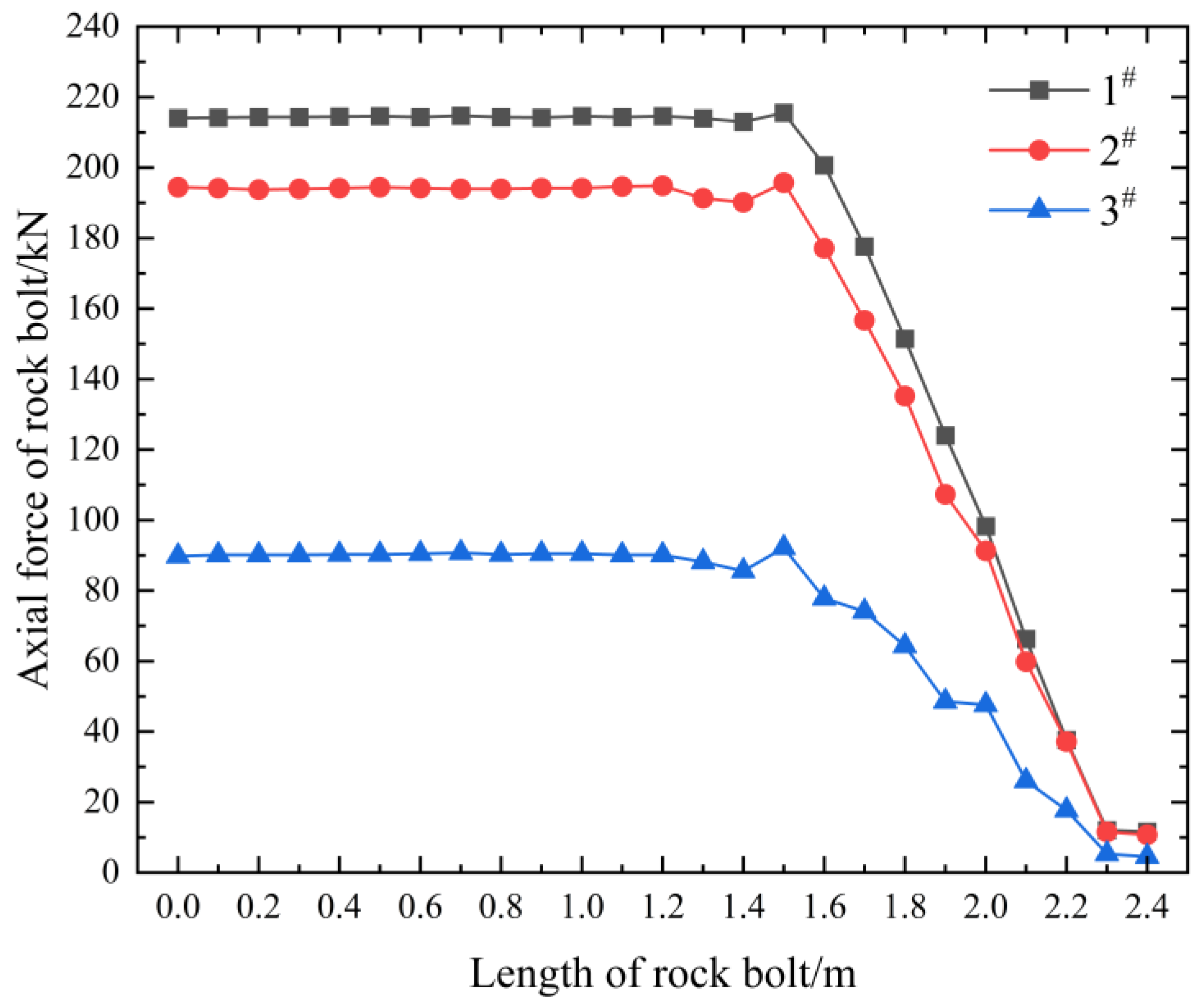

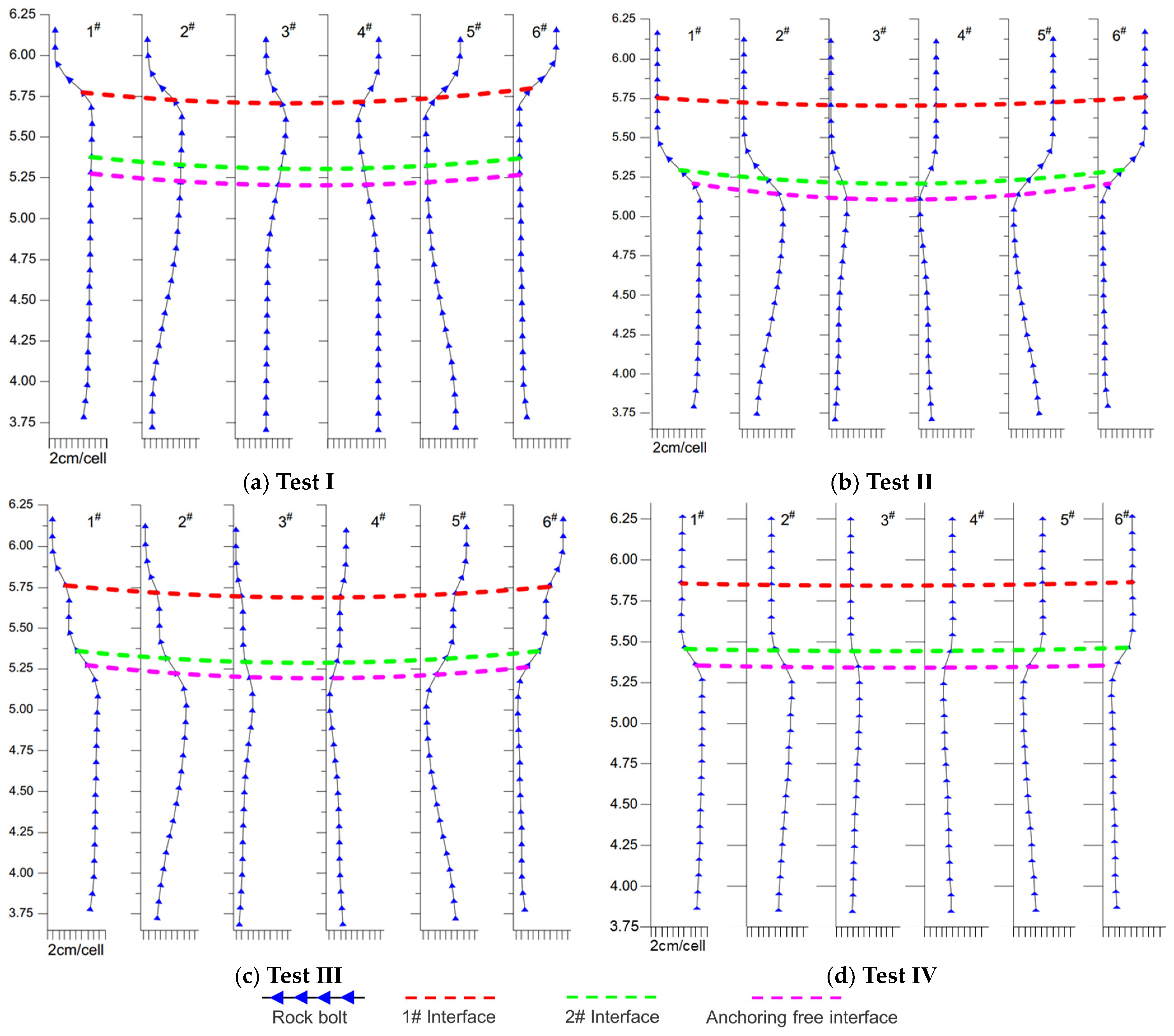

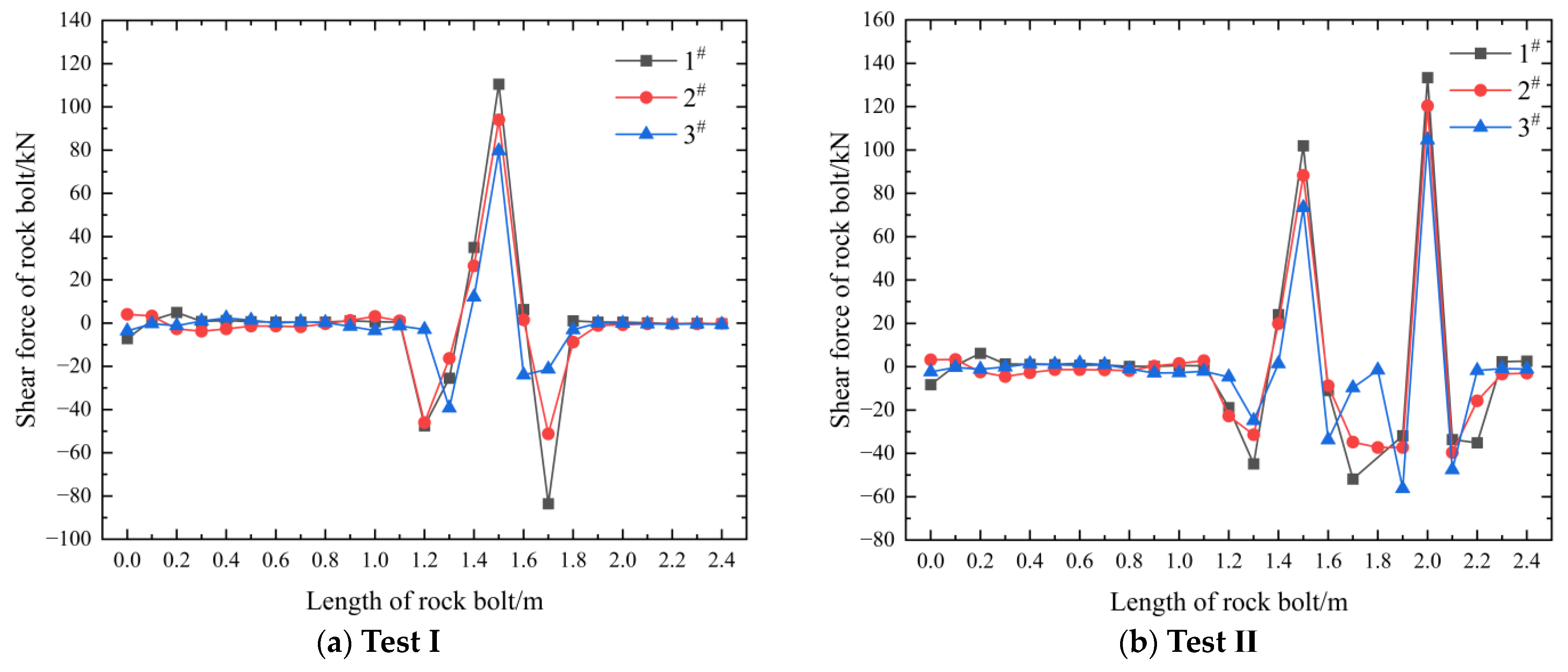
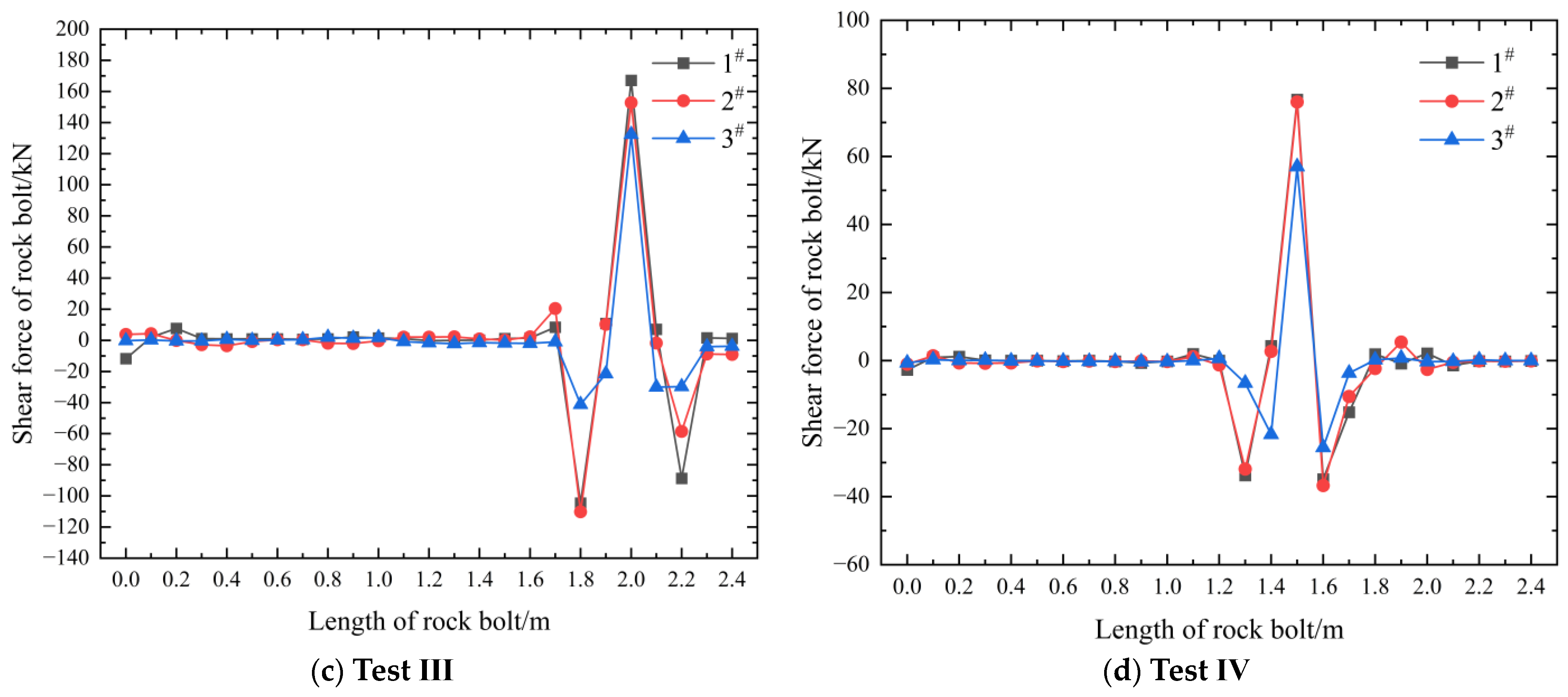
| Bedding Plane Number | Height/m | Normal Stiffness/GPa/m | Tangential Stiffness/GPa/m | Tensile Strength/MPa | Cohesion/kPa | Friction Angle/° | Dilatancy Angle/° |
|---|---|---|---|---|---|---|---|
| 1 | 6 | 1 | 1 | 0.1 | 10 | 20 | 6 |
| 2 | 10.1 | 1 | 1 | 0.1 | 10 | 20 | 6 |
| 3 | 10.3 | 0.8 | 0.8 | 0.08 | 8 | 16 | 4.8 |
| 4 | 10.5 | 1 | 1 | 0.1 | 10 | 20 | 6 |
| 5 | 10.7 | 1 | 1 | 0.1 | 10 | 20 | 6 |
| 6 | 10.9 | 0.8 | 0.8 | 0.08 | 8 | 16 | 4.8 |
| 7 | 11.1 | 1 | 1 | 0.1 | 10 | 20 | 6 |
| 8 | 11.4 | 1 | 1 | 0.1 | 10 | 20 | 6 |
| 9 | 11.9 | 0.8 | 0.8 | 0.08 | 8 | 16 | 4.8 |
| Rod Diameter db/mm | Rod Length L/m | Elastic Modulus of Rod Eb/GPa | Yield Strength of Rod σs/MPa | Drilling Diameter/mm | Elastic Modulus of Resin Anchoring Agent Eg/GPa | Shear Strength of Anchoring Interface Sp/MPa | Poisson’s Ratio of Resin Anchoring Agent vg |
|---|---|---|---|---|---|---|---|
| 22 | 2.4 | 200 | 500 | 30 | 16 | 30 | 0.4 |
| Elastic Modulus/Pa | Poisson’s Ratio | Cross-Sectional Area/m2 | Perimeter/m | Yield Force/N | Moment of Inertia Iy/m4 | Moment of Inertia Iz/m4 | Polar Moment of Inertia/m4 | Bond Force (cs-scoh)/(N/m) | Bond Stiffness (cs-sk)/(N/m2) |
|---|---|---|---|---|---|---|---|---|---|
| 200 × 109 | 0.25 | 3.8 × 10−4 | 0.094 | 2.47 × 105 | 1.15 × 10−8 | 1.15 × 10−8 | 2.3 × 10−8 | 4.37 × 105 | 3.3 × 107 |
| Test Number | I | II | III | IV |
|---|---|---|---|---|
| 1# Interface strength | High | Low | Low | High |
| Coal seam 1 | High | High | Low | Low |
| 2# Interface strength | Low | High | High | Low |
| Coal seam 2 | Low | Low | Low | High |
Disclaimer/Publisher’s Note: The statements, opinions and data contained in all publications are solely those of the individual author(s) and contributor(s) and not of MDPI and/or the editor(s). MDPI and/or the editor(s) disclaim responsibility for any injury to people or property resulting from any ideas, methods, instructions or products referred to in the content. |
© 2024 by the authors. Licensee MDPI, Basel, Switzerland. This article is an open access article distributed under the terms and conditions of the Creative Commons Attribution (CC BY) license (https://creativecommons.org/licenses/by/4.0/).
Share and Cite
Wang, Z.; Fang, S.; Zhang, C. Deformation Characteristics and Response Factors of Rock Bolt Body in Roadway with Layered Composite Roof. Appl. Sci. 2024, 14, 6694. https://doi.org/10.3390/app14156694
Wang Z, Fang S, Zhang C. Deformation Characteristics and Response Factors of Rock Bolt Body in Roadway with Layered Composite Roof. Applied Sciences. 2024; 14(15):6694. https://doi.org/10.3390/app14156694
Chicago/Turabian StyleWang, Ziyue, Shangxin Fang, and Cun Zhang. 2024. "Deformation Characteristics and Response Factors of Rock Bolt Body in Roadway with Layered Composite Roof" Applied Sciences 14, no. 15: 6694. https://doi.org/10.3390/app14156694
APA StyleWang, Z., Fang, S., & Zhang, C. (2024). Deformation Characteristics and Response Factors of Rock Bolt Body in Roadway with Layered Composite Roof. Applied Sciences, 14(15), 6694. https://doi.org/10.3390/app14156694







